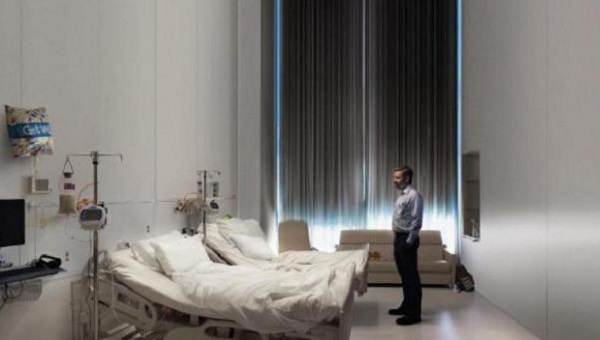“If this is all an act, I will take my electric razor, shave off your hair, and make you eat your own hair.”
Lock up your sons and daughters! There’s a Lanthimosian monster on the loose, and he’s got some scales of fate and fairness to balance in THE KILLING OF A SACRED DEER. Returning to the big screen after his acclaimed feature film, THE LOBSTER, Greek director Yorgos Lanthimos takes us on a sinister journey into the privileged life of the Murphys – very much the intact, nuclear family of two children and a mother and father – who work as an ophthalmologist and cardiologist respectively. Their jobs and subsequent wage brackets have bought them an enviable upper-middle class lifestyle in a sprawling suburban house; it would all seem quite perfect if it wasn’t for the utterly sinister overlying score from Johnnie Burn – discordant operatic numbers and harmonium drones decaying into synthesised pulsing. What could possibly puncture this American dream? Enter 16 year-old Martin.
Steven Murphy – played by Colin Farrell: five stone lighter and with a full-on edge-of-wilderness beard compared to his moustached role in THE LOBSTER – is meeting Martin, played with a sinister aloofness by Barry Keoghan, outside work: at diners, by the riverside, and at Martin’s mum’s house. It would all appear quite natural and paternal if Martin knew any other members of the Murphy family. He doesn’t, however, and there is a clandestine, unsettling tone to their meet-ups that will gradually unravel with disturbing consequences. The stilted delivery of lines, a recognisable trait of Lanthimos’s films, adds to a creepy aura surrounding Keoghan’s performance as Martin. Think Damien from THE OMEN, mixed with Tye Sheridan’s Ellis in the 2012 drama MUD, and you go some way to capturing the spiritual, malevolent otherworldliness that Keoghan depicts.
The film commences with an extreme close-up of open heart surgery, and this may or may not be referencing a catalytic moment to come later on, which is the rule, the gravity of the film, in a similar way to THE LOBSTER’s “find a mate or you’ll be turned into an animal” scenario. Here, the scales of justice must be balanced. When a life is lost from one family, another life must be taken from the family responsible. The symbolism of the titular sacred deer – an innocent , gentle, soft creature – and the sacrifice that must be enacted in order to appease an angered deity runs throughout THE KILLING OF A SACRED DEER. Martin is a Loki-esque character in the narrative – his mischief spreading first through cardiologist Steven Murphy, and then virus-like throughout the rest of the family. Carol Morely’s THE FALLING featured dramatic fainting fits, which Lanthimos seems to echo in the sudden paralysis of Murphy children Kim (Raffey Cassidy) and Bob (Sunny Suljic). Their bodies move from being self-supportive to a suddenly collapsed version of themselves: from rigid toy figurines to pathetic ragdolls. The glistening, modernist, private hospital setting of over half of the film compounds the hopelessness of their situation, as all physical causes of their paralysis are ruled out. But could it be something to do with Martin, and his wicked ways?
The glistening, modernist, private hospital setting of over half of the film, compounds the hopelessness of their situation, as all physical causes of their paralysis are ruled out.
Nicole Kidman convincingly portrays the collected, informed mother Anna in the nuclear family unit. Anna balances work and family life with watering the plants in the garden and role-playing the motionless body of an anesthetised patient in sexual encounters with her husband Steven. She too picks up on the attraction of his hands, stating, “You have beautiful hands, I’ve never noticed before, everybody’s been telling me recently.” Lanthimos draws us to the dexterity and skill of a cardiologist’s hand: the power of life over death these hands can hold with one twitch will be tested throughout the film. Of note is the sterling work done by the film’s cinematographer, Thimios Bakatakis, in conveying at once the up-close minutiae of the character’s lives, and in the same shot, pulling back and dragging the camera high up above them. In the foyer of the hospital, for instance, we watch a child lose control of his legs, collapse and sprawl out on the floor, whilst his mother struggles to shore him up and call for help. Shots like these put the audience in the visual space of puppet-master – observing with cold detachment the effects of loosening each character’s taut strings of support. This sense of height and distance from the characters is displayed in the first poster for the film revealed at the Cannes Film Festival this week.
Lanthimos’ unique style of filmmaking that gets him called back to Cannes for each new film he makes. Interesting that he has chosen to make a second film in the English language, rather than his native Greek, but even more exciting that he keeps making such bizarre, discomforting cinema, and refuses to bow to the blockbuster, studio-driven route that a lot of arthouse directors have ended up moving toward. Here’s to the creation and destruction of many more sacred deers from this intriguing director.


